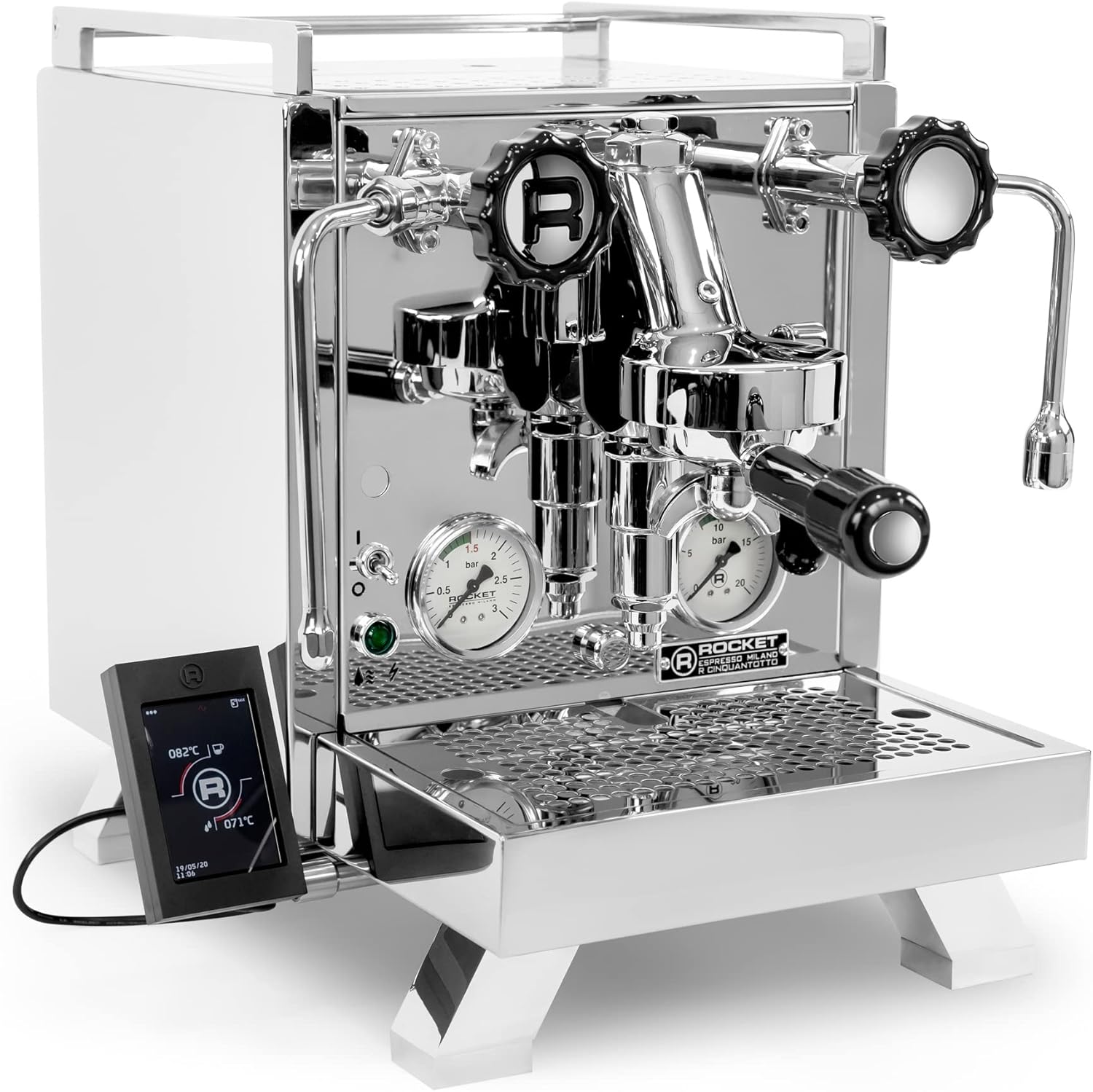Commercial espresso machines are the backbone of the coffee industry, transforming simple beans into complex, flavorful drinks. These sophisticated devices blend precision engineering with artisanal craftsmanship to produce consistent, high-quality espresso shots at scale.
PureCoffeeCraft is a participant in the Amazon Services LLC Associate Program, an affiliate advertising program created for sites to earn fees by advertising and linking to Amazon. If you are making a purchase at Amazon today, please click on one of my links. There is no extra cost for consumers who purchase from links.
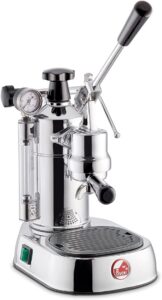
La Pavoni PC-16 Professional Espresso Machine
LaPavoni Professional – Manual lever operation, stainless steel heating element, durable design. This is for experienced coffee enthusiasts who want a machine that offers extensive control and customization for brewing.
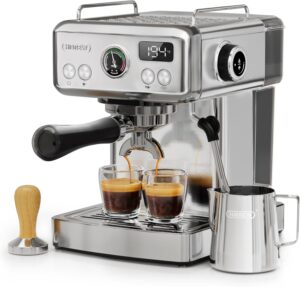
HiBREW Programmable Espresso Machine, H10A, Brushed Stainless Steel
HiBREW H10A – Semi-automatic, 20-bar pressure, compatible with Nespresso capsules, removable water tank. This is a stylish espresso machine that offers customizable brewing options and delivers high-quality espresso.
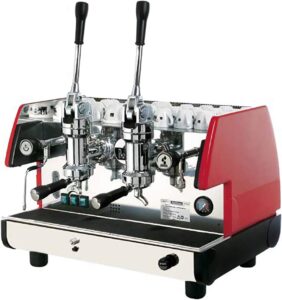
LaPavoni Bar T Series – 2-group commercial machine, durable build, 120V voltage, ideal for high-volume use. A robust commercial espresso machine that delivers exceptional espresso quality and can handle high volumes.
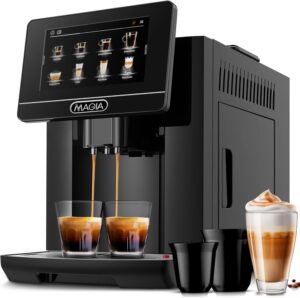
Click here to see the Zulay Magia Fully Automatic Espresso Machine With Grinder
Zulay Magia Super Automatic – Fully automtic, customizable brewing settings, touchscreen interface, 18 user profiles. A high-tech espresso machine with customizable features and a user-friendly interface for a premium coffee experience.
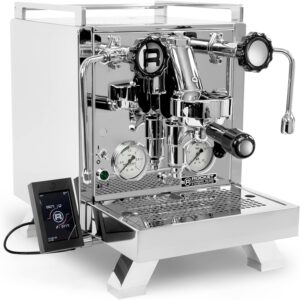
Click to see the features and information of the Rocket Espresso R58 Cinquantotto
Rocket Espresso R58 Cinquantotto Espresso Machine – 2.5 liter, 1000 Watt, 110 volts. A shot timer offers easy viewing of rew times. This commercial-caliber rotary pump has long life and plumbing of water line is allowed. The touchscreen PID is detachable for easy access to temperatures and settings.
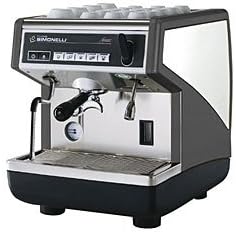
Click here for information on the Nuova Simonelli Appia Volumetric 1 Group Espresso Machine
Nuova Simonelli Appia I– Renowned for reliability, ergonomic design, high performance for cafes.
The Evolution of Espresso Excellence
The story of commercial espresso machines is one of continuous innovation. It all began in 1884 when Angelo Moriondo patented the first steam-driven “instantaneous” coffee beverage making device.
However, it was Luigi Bezzera’s patents in 1901 that laid the groundwork for the modern espresso machine.
A significant leap forward came in 1947 when Achille Gaggia introduced the lever-operated machine. This invention gave birth to the crema-topped espresso we know and love today.
The pressure created by the lever allowed for the extraction of essential oils and colloids from the coffee, resulting in a richer, more complex flavor profile.
Modern professional machines have come a long way from these early designs. Today’s top-of-the-line equipment incorporates advanced features that early pioneers could only dream of:
- PID (Proportional-Integral-Derivative) temperature control systems confirm precise and stable brewing temperatures.
- Pressure profiling allows baristas to customize the extraction process for different coffee beans and roasts.
- Volumetric dosing guarantees consistency across hundreds of shots.
- Telemetry systems enable remote monitoring and maintenance, reducing downtime and improving efficiency.
These technological advancements have enhanced the quality and consistency of espresso but have also revolutionized café operations. Baristas can now focus more on customer service and drink presentation while relying on their machines to deliver consistently excellent espresso shots.
Pursuing Precision
Commercial espresso machines stand apart from home models in their relentless pursuit of consistency and quality at scale. These machines are built to withstand the demands of producing hundreds of shots per day, with some high-end models capable of churning out up to 240 espressos in a single hour.
Several key features contribute to their superior performance:
High-Pressure Extraction
While home machines typically operate at 9 bars of pressure, commercial machines often use 15-20 bars. This higher pressure allows for more nuanced extraction and fuller flavor profiles.
The ability to adjust pressure during the shot (pressure profiling) gives baristas even more control over the final taste of the espresso.
Temperature Stability
Advanced boiler systems and PID controllers confirm that water temperature stays constant throughout the day. This stability is crucial for maintaining flavor consistency from the first shot to the last.
Some high-end machines even feature many boilers, allowing for simultaneous brewing and steaming without temperature fluctuations.
Customization Capabilities
Many top-tier machines can be programmed with up to 100 different drink recipes. This feature allows cafés to offer a diverse menu and personalize drinks to meet the demands of even the most discerning customers.
Baristas can save specific parameters for different coffee beans, ensuring optimal extraction for each variety.
Durability and Longevity
Built to last, commercial espresso machines often have a lifespan of 7-10 years with proper maintenance. This longevity makes them a sound long-term investment for businesses serious about their coffee offerings.
High-quality materials like stainless steel and brass components contribute to their durability and resistance to wear and tear.
The Price of Perfection
Quality comes at a cost, and high-end commercial espresso machines can set businesses back upwards of $20,000. However, this investment often pays dividends in terms of drink quality, operational efficiency, and customer satisfaction.
A 2018 report by the Specialty Coffee Association found that 72% of specialty coffee shops prefer semi-automatic machines. This choice reflects a want to balance the consistency of automation with the artisanal touch of skilled baristas, allowing for both efficiency and creativity in coffee preparation.
Some of the latest innovations include:
AI-Powered Brewing
Artificial intelligence is making it’s way into espresso machines, with some models using machine learning algorithms to improve extraction based on factors like bean origin, roast level, and even ambient conditions.
Sustainable Solutions
From biodegradable components to solar-powered models for outdoor events, eco-consciousness is brewing in the industry. These innovations reduce environmental impact and appeal to increasingly environmentally aware consumers.
Virtual Reality Training
Baristas can now hone their skills in immersive, risk-free virtual environments. This technology allows for comprehensive training without the pressure of a busy café setting, ensuring that new staff members are well-prepared before they step behind the bar.
Blockchain Integration
Some machines are incorporating blockchain technology to track coffee bean sourcing. This feature appeals to ethically-minded consumers and provides transparency in the supply chain, allowing cafés to showcase the provenance of their beans.
Navigating the Challenges
While the allure of perfect espresso is strong, commercial machines come with their own set of challenges that café owners and operators must navigate:
Maintenance Matters
Regular descaling (every 3-6 months) and professional servicing are crucial for longevity. Neglecting maintenance can lead to costly repairs and downtime.
Establishing a rigorous maintenance schedule is essential for keeping these complex machines in top condition.
Energy Consumption
These powerful machines can be energy-hungry, though newer models boast up to 30% energy savings. Balancing performance with energy efficiency is an ongoing challenge for manufacturers and café owners alike.
Some cafés are turning to energy management systems to improve their power usage during peak and off-peak hours.
Training Requirements
The complexity of these machines necessitates comprehensive staff training. Investing in proper training is essential to maximize the machine’s potential and maintain consistency in drink quality.
Many manufacturers offer training programs, and some cafés are developing in-house training curricula to confirm their staff are fully versed in their specific equipment.
Space Considerations
High-end machines can be substantial, posing challenges for smaller cafés with limited counter space. Careful planning and layout design are crucial when integrating these machines into a café environment.
Some manufacturers are responding to this challenge by developing more compact models that don’t sacrifice performance.
The Environmental Angle
Sustainability has become a key concern in all industries, and the coffee world is no exception. A 2021 study by the Coffee Roasters Guild revealed that energy-efficient commercial coffee machines can reduce a café’s carbon footprint by up to 25%.
This finding is driving innovation in eco-friendly designs and practices, with manufacturers focusing on:
- Water efficiency: New systems recycle water used in the cooling process, reducing overall water consumption.
- Energy-saving modes: Smart power management systems put machines into low-power states during quiet periods.
- Recyclable or biodegradable components: Some manufacturers are exploring alternative materials to reduce the environmental impact of machine production and disposal.
- Reduced waste in milk frothing systems: Advanced milk systems minimize waste and improve the efficiency of milk-based drink preparation.
The Human Touch in a Mechanical World
Despite the advanced automation available in modern espresso machines, the role of the skilled barista stays crucial. The best machines are designed to enhance, not replace, the barista’s craft. They provide tools for consistency and efficiency while still allowing for the human touch that can elevate a good espresso to a great one.
Baristas play a vital role in:
- Dialing in the grind: Adjusting the grind size to account for changes in humidity, temperature, and bean freshness.
- Customizing drinks: Using their knowledge and creativity to craft unique beverages that go beyond standard menu items.
- Maintaining equipment: Performing daily cleaning and maintenance tasks to keep the machine running smoothly.
- Educating customers: Sharing their knowledge about coffee origins, roasts, and brewing methods with interested patrons.
Future Trends
As we look to the future of commercial espresso machines, several trends are emerging:
Internet of Things (IoT) Integration
Machines are becoming increasingly connected, allowing for real-time monitoring of performance metrics, predictive maintenance, and even remote diagnostics. This connectivity can help café owners improve their operations and reduce downtime.
Personalization at Scale
Advanced user interfaces and cloud-based systems are making it possible for cafés to offer highly personalized drinks while maintaining efficiency. Customers may soon be able to save their preferred drink recipes and have them replicated perfectly at any location.
Sustainable Materials and Practices
As environmental concerns continue to grow, we can expect to see more machines made from recycled or biodegradable materials. Energy and water efficiency will likely become even more critical selling points for new models.
Enhanced Milk Systems
Improvements in milk frothing technology will continue, with a focus on creating perfect microfoam for latte art and reducing waste. Some machines may incorporate plant-based milk choices directly into their systems.
Modular Design
To address space concerns and allow for easier upgrades, some manufacturers are exploring modular designs. These would allow café owners to add or replace components as needed, as opposed to investing in entirely new machines.
Exercises for the Aspiring Coffee Professional
To truly understand the capabilities of professional espresso machines, consider these exercises:
Pressure Profiling Practice
If you have access to a machine with pressure profiling, experiment with different pressure curves and note how they affect the flavor of the espresso. Try starting with a low pressure pre-infusion, ramping up to full pressure, and then tapering off towards the end of the shot.
Compare this to a flat pressure profile and note the differences in taste and mouthfeel.
Temperature Stability Test
Pull several shots in succession and use a thermometer to check the consistency of the espresso temperature. This will help you appreciate the importance of temperature stability in high-volume settings.
Try this at different times of day and under various conditions to see how the machine performs.
Milk Frothing Challenge
Practice creating different milk textures for various drinks, focusing on consistency and microfoam quality. Try to achieve the perfect silky texture for lattes and the drier foam needed for cappuccinos.
Experiment with different milk types and temperatures to understand how they affect the frothing process.
Cleaning and Maintenance Drill
Familiarize yourself with the daily, weekly, and monthly maintenance routines for a commercial machine. Time yourself to improve efficiency.
Create a checklist and try to improve the process without sacrificing thoroughness.
This skill is crucial for keeping the machine in top condition and ensuring consistent drink quality.
Recipe Programming
Create and save many drink recipes on a programmable machine, then test for consistency across different baristas. This exercise will help you understand the balance between automation and the human touch in drink preparation.
Try to create a signature drink that showcases both the machine’s capabilities and your creativity.
In Review
- Commercial espresso machines are complex, precision instruments that require significant investment and expertise to operate effectively.
- The best machines offer a balance of consistency, customization, and efficiency to meet the demands of high-volume coffee service.
- Ongoing maintenance and proper training are crucial for maximizing the potential of these machines.
- Sustainability and energy efficiency are becoming increasingly important factors in machine design and selection.
- Despite technological advancements, the skill of the barista stays a critical factor in producing exceptional espresso.
- The future of commercial espresso machines comes from the integration of AI, personalization, and sustainable technologies.
People Also Asked
What is the best commercial espresso machine for a small café?
The best commercial espresso machine for a small café depends on factors like budget, space, and expected volume. Popular options include the La Marzocco Linea Mini and the Nuova Simonelli Appia II.
How much does a commercial espresso machine cost?
Commercial espresso machines can range from $2,000 for entry-level models to over $20,000 for high-end, multi-group machines. The price depends on features, brand, and capacity.
How long do commercial espresso machines last?
With proper maintenance, a high-quality commercial espresso machine can last 7-10 years or more. Regular servicing and cleaning are essential for longevity.
What is pressure profiling in espresso machines?
Pressure profiling allows baristas to adjust the pressure during extraction, creating different flavor profiles. It can enhance certain characteristics of the coffee and produce more complex espressos.
Are automatic or semi-automatic espresso machines better for cafés?
The choice between automatic and semi-automatic machines depends on the café’s needs. Automatic machines offer consistency and ease of use, while semi-automatic machines allow for more barista control and creativity.
How often should a commercial espresso machine be serviced?
Commercial espresso machines should be professionally serviced at least once a year. Daily cleaning and weekly maintenance tasks should also be performed by café staff.
What is PID temperature control in espresso machines?
PID (Proportional-Integral-Derivative) temperature control is a system that maintains precise and stable brewing temperatures. It helps confirm consistency in espresso extraction.
Can commercial espresso machines be energy-efficient?
Yes, many modern commercial espresso machines are designed with energy efficiency in mind. Features like standby modes and improved insulation can reduce energy consumption.
What is the difference between a heat exchanger and a dual boiler espresso machine?
Heat exchanger machines use a single boiler for both brewing and steaming, while dual boiler machines have separate boilers for each function. Dual boiler machines generally offer more temperature stability and control.
How important is water quality for commercial espresso machines?
Water quality is crucial for espresso machine performance and longevity. Using filtered water can prevent scale buildup and improve the taste of the espresso.
